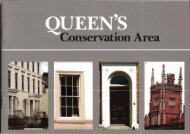Killyleagh Conservation Area (March 1993) - The Planning Service
Killyleagh Conservation Area (March 1993) - The Planning Service
Killyleagh Conservation Area (March 1993) - The Planning Service
Create successful ePaper yourself
Turn your PDF publications into a flip-book with our unique Google optimized e-Paper software.
I KILLYLEAGH<br />
dI CONSERVATION AREA 1' <br />
I
KILLYLEAGH <br />
CONSERVATION<br />
AREA<br />
1.0 INTRODUCTION<br />
2.0 BOUNDARY OF CONSERVATION AREA<br />
3.0 NEED FOR DESIGNATION<br />
4.0 THE DESIGNATION<br />
DESIGNATION<br />
DOCUMENT<br />
5.0 HISTORICAL DEVELOPMENT<br />
6.0 TOWNSCAPE<br />
7.0 DESIGN GUIDELINES<br />
8.0 APPENDICES<br />
DIVISIONAL PLANNlNG OFFICE<br />
RATHKELTAIR HOUSE <br />
MARKET STREET <br />
DOWNPATRICK <br />
APRIL <strong>1993</strong>
-<br />
i<br />
l<br />
1<br />
- --.<br />
: l :<br />
- -<br />
INTRODUCTION
1.0 INTRODUCTION<br />
<strong>The</strong> modern town of Killy1eagPn is a<br />
product: of the Ulster Plantation of<br />
the 17th century although there is<br />
evidencc of earlier settlement by both<br />
the Normans and the Uaels. This small<br />
County Down town, rich ha histofy, is<br />
the proud ps~es~~r<br />
of an e-<br />
heritage which cdd~~ates s-cularIy<br />
in KUylagh Castle. Set amongst<br />
rullhg drumlins at the edge of<br />
Straagford Lough, the 6uilt<br />
environment<br />
combines<br />
beautifully with<br />
the natural<br />
landscape to<br />
create a quite<br />
unique sease<br />
of plaa<br />
<strong>The</strong> P- (NI) Order 1991 provides<br />
the basis far the protection of the<br />
mince's heritage of buildings of<br />
spacial architectural interest sad for the<br />
designation of whole areas of sbdar<br />
intemt the ewer or appearance of<br />
which it is desirable to preserve or<br />
enhance.<br />
<strong>The</strong> historic importance aad quality of<br />
the towxirape of <strong>Killyleagh</strong> warrants<br />
the action af the Department of the<br />
Environment for Northcm Ireland in<br />
designating much of the town as a<br />
Co~~~emtion<br />
<strong>Area</strong> uader the<br />
terms of<br />
Article 50 of<br />
the Phming<br />
W11 -er<br />
LW.
BOUNDARY OF <br />
THE <br />
CONSERVATION <br />
AREA
2.0 BOUNDARY OF THE<br />
CONSERVATION AREA<br />
<strong>The</strong>tnwnofKillyIeaghIsan<br />
expression in the and space of<br />
the convergence of a unique<br />
combhation of demapts buildings,<br />
streets, %pacesand hdscape. <strong>The</strong><br />
geographical extent of the<br />
Consemadon <strong>Area</strong> b a refldom of<br />
the intmdationship betweem these<br />
elements of townscape rather than 51<br />
fgcus on the qualities of irpdividual<br />
buildings or groups of buildings.<br />
<strong>The</strong> boundguy encloses therefore not<br />
only the wrigiial Jacobean town a d<br />
Castle, but d o the Harbour area and<br />
Dibncy River valley and Cslw additions<br />
such as Plantation S W and the<br />
complex of nineteenth century mill<br />
blaiIdings on the samherrz margin of<br />
the town,<br />
<strong>The</strong> historic core of <strong>Killyleagh</strong> is<br />
composed of pleast~ntlyenclosed<br />
Georgian and Victorian terraces which<br />
display much orighd detailing such as<br />
fanlights, coach arch-, quoins, whed<br />
windows and original stonework. Nigh<br />
Surctt. Cathe- Street and Fderick<br />
Street, m well as contahhg the bulk<br />
of the t&s Eisted buildings. provide<br />
rewarding internal vistas and external<br />
views. Elsewhere, as in Cmss S-,<br />
change of scale and building hine<br />
provide visual interest w&t key corner<br />
sit- offer opportunities far<br />
enhanvt and impmvement.<br />
<strong>The</strong> Harbour area is included as an<br />
acknowlegement of the qualities<br />
inherent in its location. Regeneration<br />
and enhancerntnt is vital if the tourist<br />
and d ollal potential of this area<br />
is to be fully exploited.<br />
<strong>The</strong> Wbncy Wver vdky encloses the<br />
town to the north providing a natural<br />
boundary to the C a d o n &ea.<br />
Clearly visible from Shrigte~rRoacP and<br />
Cumber Road it contributes<br />
~i~cafltly to the landscape and<br />
s&g of the tm.
Designation should assist urban<br />
regeneration by:<br />
(a) Providing a Wework for tbe<br />
protection of the tmmts heritage<br />
and guiding dweIopers to ensure<br />
that, future change rmpeas the<br />
character of the C o~tion<br />
<strong>Area</strong>-<br />
(b) Encouraging a sense of pride<br />
amdng property ownem in the<br />
historic core of <strong>Killyleagh</strong> and<br />
pfovidiug an opportunity to<br />
dwelop the individual character of<br />
tfie <strong>Conservation</strong> h a with<br />
potential for inmd visitor<br />
attraction and resulting btnefits to<br />
trade and employment in the area.<br />
(c] Providing a focus for civic pride h<br />
the history and architectaral<br />
heritage of their town.<br />
(d) Providing an opportunity for<br />
enbaacement of the Comemation<br />
<strong>Area</strong> fofl~fwingdes&pudon.<br />
Making available grant-aid from<br />
the Dqpm%mcint1eComemation<br />
<strong>Area</strong> md Environmed<br />
Improvement funds for<br />
imprmements to property and<br />
public spaces in the <strong>Conservation</strong><br />
<strong>Area</strong>.
Notice is he- dven that the Born District Council<br />
Department of the Environment 24 Strangf0l-d Road<br />
CM) in pursuance: of powers anfed<br />
upon it by Article 50 of the <strong>Planning</strong><br />
(NI)Under <strong>1993</strong> has designated the<br />
DOWWATRICK<br />
BT36 6SR<br />
lkk 03% 614331<br />
area outlined on the accompanying<br />
map as a <strong>Conservation</strong> <strong>Area</strong> bdng an Dlvisidnal Plannin&Office<br />
area of specid architectural i m ~ ~ c Rathkeltair e &use<br />
or histolic interest the maer of<br />
which it is desirable to p m e or<br />
Market Street<br />
Downpatrick<br />
enhpine A map of the designated ama m30 6EA<br />
has been aepO8Ited at the District 'RI: 03% - 612211<br />
Coutleil Offices in Downpattick aad<br />
the Divisional <strong>Planning</strong> Offme in<br />
Dawnpl3uick at the admm indicated<br />
below:<br />
THE<br />
OESEGNAf
L <br />
DEVELOPMENT
5.0 HISTORICAL<br />
DEVELOPMENT<br />
Situated on the western shorn of<br />
Svaagford hgh five miles north<br />
east of Dawnpatrick, the town of<br />
Kiliykagh was a port of some<br />
eminence priar to the conquest of<br />
Ireland by the Anglo-Normans. A<br />
remote ndaw of the present town is<br />
believed to have becn formed by the<br />
MasArtW (anglicised to -1<br />
who possessed extensive territory h<br />
East Down. Upon the conquest of the<br />
maritime parts of Ulster, Sir Job de<br />
Cowey appears to hawe retarded<br />
K1Uyleagh as a place of some<br />
importance and around 1177AD<br />
adopted it as the site of one of his<br />
W e s and principal stttlements. In the<br />
early 17th ccntslry the manor and<br />
district of KiWIeagh wert graated by<br />
Jam- KI to Sir Jarnes Hamilton who<br />
mtorod and comidd1y enlarged the<br />
castle which he made his principal<br />
Teaideace. <strong>The</strong> present form of<br />
Killyleagb dates from this time. In 1425<br />
it had ninety houses laid out in<br />
cruciform fashion and by the 1830's<br />
there were two hundred and swen<br />
houses, arranged in two nearly parallel<br />
streets intersected by a longer one. This<br />
is the street layout whlch remains the<br />
basis of the settlement today.<br />
<strong>The</strong> town grim steadily anand as the<br />
17th and 18th cenrurlcs pmgresd.<br />
Killyleaj&, which had originally<br />
becn a village of farmers<br />
dusted round the Castle for<br />
protection, became a market<br />
centre This reflected the<br />
hicreased product3Vity of<br />
thc farming community<br />
which, by then. was able to<br />
grow more than it<br />
needed, W much so that<br />
k 1725, the 41bm<br />
Corporation gave a<br />
tenement for the<br />
erection of a market<br />
bouge. 'ib stu this<br />
susplu&tbe groarth<br />
of the port was<br />
encouraged since<br />
transport and
communication over land was difficult.<br />
Cottage industry based upon handloom<br />
Linen adso pro~ptmd.<br />
l':<br />
With the 19th cxmtury came<br />
manufacturing industry, although in<br />
1833 the Corporation Comtnissionenr<br />
Report stated that "the town was<br />
impraving but still extremely limit;ed in<br />
extent and populationn:'At the same<br />
time, however, cotton manufacnuing<br />
was being carried out on an aaonsive<br />
scale in nearby Shrigley* large s3x storey<br />
mills having bem ~ li8h.dthere to<br />
take advantage of the water supply<br />
ffom the Dibney Rivu. <strong>The</strong> track of<br />
the porr cansistcd principally ia the<br />
errport of whtat, barley, oats,<br />
bu*~ U p and cotton goods; and the<br />
import of rotton wool, coal, iron, salt<br />
and gmeral ~ C I <strong>The</strong> C harbour ~<br />
was described as well shcltmcd and<br />
acc#sible to vesssla drawing not more<br />
than ten feet of we* and the quay<br />
and basin were completed in 1833.<br />
<strong>The</strong>m wue also exwmive qudc8 of<br />
bdt and ~Iaydate from wbich were<br />
talten 'the whole of the stancs of<br />
which the town is built:
<strong>The</strong> construction of the <strong>Killyleagh</strong> flax<br />
spidg mill in 1852 signalled the<br />
arrival of manufacturing industry in<br />
the town itself. Between 1831-71. the<br />
population of the town in-ed by<br />
55Wo and the proportion engaged in<br />
agricuhuxe contipacd to fa<br />
By the late 19th century the growth of<br />
BeIfast had undermined the role of the<br />
town as a market town and port. At<br />
the same time KillyIeagh's importance<br />
as an indastrid and service centre for<br />
the nmomding district increased. In<br />
1900 the <strong>Killyleagh</strong> and Shrigley mills<br />
employed 1500 people and the town<br />
bad finally ceased to be the residence<br />
of farnnets.<br />
Prosperity continued into the early<br />
20th century without affecting the<br />
physical structure of the town<br />
significantly? but by P931 with the<br />
closure of the Shrigley mill, economic<br />
decline was setting ih. She the<br />
Second World War the town has grown<br />
far beyond its original coflnts, with<br />
the construction of several new housing<br />
estates on the outskirts.<br />
IPbday KiUyieagh functions as a small<br />
maaufmring town and local service<br />
centre for the surrounding sum1 area<br />
and with the establishment of two<br />
yacht clubs and a sailing centrc in the<br />
vicinity, it has become aa important<br />
yachting centre, <strong>The</strong> population of the<br />
t m now stands at muad 2300 and<br />
with available housing h d there is the<br />
passibility of wesl more dcvelolpment.<br />
If the chatacter and integrity of the<br />
town are to be protected in the face of<br />
further change, camfuf management<br />
and sensitive guidance will be required.
6 <br />
TOWNSCAPE<br />
I '
E'<br />
m1<br />
6.0 TOWNSCAPE<br />
<strong>The</strong> btautifad natural setting of<br />
<strong>Killyleagh</strong>, its layout and the<br />
buildings of its historic core have<br />
combined with the passing years to<br />
produce zt twvnscape rich in interest<br />
and diversity. Tht Castle on the hill at<br />
the head of the town with its high<br />
conical turrets rising through the trecs;<br />
the roofs and chimney stacks of the<br />
surromding huddle of domestic<br />
buildings, warthousts and shedq<br />
punctuated by church towers and<br />
spires, the internal vistas and external<br />
views afforded by the intimate layout<br />
of the streets; the harbour at the foot<br />
of the hill with its vim across<br />
Smgford Lnugh to the low sibouette<br />
of &a Apds peninsula; these are the<br />
qualities of <strong>Killyleagh</strong> which make its<br />
designation as a Camervation <strong>Area</strong><br />
appropriate.<br />
Tht Cansewation Arca covers the<br />
Castle area, High Street, Fraderick<br />
Street. Catheriae Stm. Conber Road,<br />
the Dibney Vaky, Cross St-.<br />
PIantation Street/CastIe Lane, Church<br />
Hi15 Irish Street, Shore Street and the<br />
Harbour area. <strong>The</strong>se streets and spaces<br />
mwtitnte the historic care of the town<br />
and a brief description of each will<br />
hopefulIy provide a clcarer picture of<br />
the dbt51dve and unique char* of<br />
Killylcagh.<br />
<strong>The</strong> Castle Ama<br />
<strong>Killyleagh</strong> Castle is an outstanding<br />
landmark of architectnral and<br />
historical significance whose present<br />
appearance owes much to the<br />
Victorian era. It can be seen not only<br />
from the t m where the vim, though<br />
framed by the surrounding streets, are<br />
somewhat Limited, but also from the<br />
countryside to the north, west and<br />
south where clearly mmmanding the<br />
bill it stands silhouetted against the<br />
sky. Within the tuwn it towers over<br />
High Street and Frederick Street. <strong>The</strong><br />
Iarge open space dividing it from the<br />
Georgian dweUings of these strocss is<br />
an important townscape element and<br />
the nearest there is in <strong>Killyleagh</strong> to a<br />
tom square
HIGH STREET, CATHERINE<br />
STREET,CROSS STREET<br />
This is the mmrewcial core of the<br />
town wen though many residential<br />
properties-are located here Tbgcther,<br />
the sftectS within the area contain thc<br />
bulk of tbe town's shops, offices and<br />
other businesse& Here dso are to be<br />
fmm~tie majority of a listed ad<br />
supplome~tarylisted bull- which<br />
give this part of KiUyhgh its air of<br />
WatJqraltr and charm.<br />
High Street is essentially a street af<br />
changing levels and Georgian buildings<br />
with the bonus of vistas at either end,<br />
It degcends from the Castk t d s<br />
Catb%rincStrtet g%ntlyat first, then<br />
more steeply, reveabg a roof<br />
line and a Mesty of roof pitch= in<br />
the process. Fmns it, there is a pIeaamt<br />
view th.rough Shore Saeet to the Laugh<br />
a d the A& ~ U I O heyand, S whilst<br />
from the -011~ of the E- 100king<br />
north wcst the Castle provides a superb<br />
visual Sm3p. It is a a m which fimts<br />
retained the itimucy ~f domdc scale<br />
and % a pleasing mWum of S-,<br />
offices, public hmms rrnd dwellings.<br />
I,.-.
<strong>The</strong> old buildings of which it is almost<br />
entirely comgosed, offer a two and<br />
three stoney irregularity of height. mof<br />
line and roof pitch often fouad in<br />
older settlements and all but a fcw<br />
have slated roofs, with the ridges<br />
&g parallel to the street. Moreover<br />
is conhim scvd listed buildings the<br />
most gable of which are located on<br />
the no&m side of the street, ie the<br />
Dufferin Anas public hoWmtaufant,<br />
and the adjoining Ulster Baak. Casz<br />
iron railings enching bWdings in<br />
upper Wgh Street provide a graceful<br />
formality reminisoeat of Georgirta<br />
terraces in more urban settings. On the<br />
southern side, particukrly noteworthy<br />
is No 18, a two storey dwelling and<br />
shop with l!ecm#isedcfolorwrry and<br />
M J t i d shop front, the twa uses<br />
visua1ly integrated by a unified<br />
painting sciwxne.<br />
For the m m part. Upper Nigh Street<br />
contains the larger buildiags many of<br />
which were originally buih as<br />
architectural units and whia have<br />
since been subdidded. <strong>The</strong> change of<br />
geru betweea larger and smaUer<br />
bltiLdings is not abmpt and the general<br />
pattern of streemape. as reflected in<br />
basic archikctd rhythms, remains<br />
unified and aMwe. Many bailwhilst<br />
not W, have retained original<br />
window openings, dazing bars, sbap<br />
f*nts and fanlighted doorways and<br />
these contribute handsomely to the<br />
character of the atre&. Particularly<br />
plmsbg arc Nos 26-30. (a eproup of<br />
two dwdhgs and a shop) and,<br />
providing a strong visual stop to the<br />
terrace, Nos 48-50.<br />
Catherhe Stteet, the malrr north-south<br />
axis of <strong>Killyleagh</strong>, is, like Wigh S-<br />
a street of mixbd c~mmercidand<br />
residential development, It channels<br />
and generates traffic and gives pasem<br />
by their first impression of the town.
<strong>The</strong> approach fFom Downpatrick bad<br />
I<br />
from them the street rises gently to the<br />
junction with High Street and Shore<br />
Strcet. Beyond, the tall trees of Gocaan<br />
Lodge provide it with a r mtd sense<br />
ofmc1osu1.e.Vimgd from the opposite<br />
direction, enclosure is again provided<br />
by the stand of trees at the base ofthe<br />
drumlin. Catherhe street k an<br />
amalgam of two and three storey<br />
buildings, predominantly the former,<br />
and it contains a number of amellent<br />
m liMd bvildingh Hem m* Ulae -*<br />
arche punctuate facades and the<br />
orighal stone paving at thcie<br />
mtrance6 give texture md variety to the<br />
footpaths. Desedng of special<br />
mention is the group of listed buildings<br />
bet- Nos 2 and 8 and the attractive<br />
2nd Pftsbykrian Church. No 8, a well<br />
maintained three storey Gcorgiaa<br />
dwt- d n s all of its orieal<br />
feature and contributes simcatltly<br />
and positively ra dawnscape quality.<br />
dwellings of shopkeepers and m-tbafls.<br />
Nowadays a jumble af mrmpemid and<br />
residential properties, it is fortunate<br />
that amongst the rnany changes which<br />
they have undergofle, their scale, at<br />
leas, survives whilst frontages are a<br />
mixture cf traditional and modem. On<br />
the western side of the street, Nos 3, 5<br />
and 7 combine well in scale md style<br />
witb. the much grander No 9. ExternaI<br />
refurbishment of these baildings would<br />
haw a major hpaa on strmscapa<br />
Catherine Street is rounded off by the<br />
tall, white painted rendered frontage of<br />
the flax mill. Formerly a four storey<br />
building it has now been reduced to<br />
two; its red brick chimneyronce visibh<br />
from twenty miles away, rivalled the<br />
chunch spire far dominance of the<br />
skyline below the Castle but the<br />
mod- replacement has none of its<br />
predecessor's charm.<br />
<strong>The</strong> dramatic change in roof hdght<br />
betwacn No 8 and the remaining two<br />
storey building8 signals a return to the
I<br />
Cross Strtat is a predominantly<br />
commercial street of two storey<br />
buildings. On the eastern side between<br />
Church Hill and Shore Street there are<br />
attractive and colourful public houses<br />
and shops which have retained original<br />
windows and door cases, <strong>The</strong> main<br />
interest, though, is provided by the<br />
scale of the buildings, and by the way<br />
in which they gently step down the<br />
slope to the Dibney River valley.<br />
Beyond the jundion with Frederick<br />
Street and Church Hill there is a mix<br />
of dwellings asld commercial premises<br />
and autbuildings. Tbe trees which<br />
overhang the road beyond the Usted<br />
Cross Street Bridge, provide enclosure<br />
to the street. Egress frwm the town is<br />
via tbc high brick d of Oacean<br />
LQdgeand the lower stone retaining<br />
wall of a high tree-topped<br />
embankment. Viewed from the north,<br />
enclosure is provided by the change in<br />
building line between Cross Stm and<br />
Cathetine Street.<br />
<strong>The</strong> Dibney Vdlq<br />
<strong>The</strong> Dibney Valley* on the northern<br />
outskirts of the town, rum parallel to<br />
Shrigley Road ad Freddck Street<br />
before turning south behind Church<br />
Hill to enter the laugh at the junction<br />
of Shore St~eotand Bridge Stmt.<br />
With its steeply sloping banks and<br />
wide vaPley fioor, it is a major<br />
landscape feature which contributes<br />
-cmtly to the sotring of the rmn.<br />
Mcularly impartant are the vicws<br />
fmm Cross Street Bridge and the view<br />
of the Castle from the valIey floor,<br />
bide the pPrmying fields. <strong>The</strong> area<br />
between Riverdale Manse and Cross<br />
Street Bridge is particularly well<br />
enclosed by stands of trees and steep<br />
valley sides.
Frederick Street was once a pleasant<br />
n m w street enclosed by the Castle at<br />
lone end and with a view of the church<br />
of Saint John the Evangelist hthe<br />
opposite direction, It wed to contain a<br />
mixture of stone warehouses and late<br />
Geargian houses, two small g~upsof<br />
which remain on opposite sides at the<br />
Castle end of the street. It was<br />
redmeloped in the 2970's however and<br />
the new housing consists of a rvvw of<br />
dwellings set back a comiderable<br />
distaacc from the origiaal building lint<br />
in a serrated pattern, exposing the<br />
gmble end of Dufferin lkmcc beyond.<br />
<strong>The</strong>y are unsympathetic to the<br />
chamcm of the historic core in almost<br />
every respect and the original enclosure<br />
of Frederick Street with the Castle as<br />
its visual stop, has bm lost. On the<br />
opposite side of the street the public<br />
car park enclosed only by a Iow<br />
remiming wall exposes the backs of the<br />
buildings In High Street. "Lb the north<br />
of the car park, in a small landscaped<br />
open spacq a wall phqut<br />
commemorates the association of<br />
Frederick Street with Sir Wans Sloaae.<br />
physician. and benefactor of the British<br />
Muscum whose home, which was built<br />
in 1637, u d to &and opposite.<br />
Church Hil is a pleasant street of two<br />
stow dweElings many of them<br />
constructed by the Nonrherpl Ireland<br />
Housing Executive with much<br />
sensitivity for the charractcr of the<br />
historic core <strong>The</strong> old and new<br />
dwellings marry well and they step<br />
nicely up the hill to the listed parish<br />
church of St John the Bvmgebt<br />
which, beauWdly sited amidst a grove<br />
of mature trees*overlooks the town<br />
and Stmngford Lough. Views of the<br />
church from FderIck Street and from<br />
the Castle Square are patticularly<br />
imporrapt elements h townscape <strong>The</strong><br />
former Rectory nearby*suffoundbd by<br />
high gardmwab aodtrew, isalso<br />
listed and is an important feature<br />
because of the prominence on Church<br />
Hill. <strong>The</strong> plaque on the Rectory wall<br />
cammemoratCS Rcv, Dr. Edward<br />
Hincks (1792-1866), an expert on<br />
Egyptian and Meaopotamism<br />
civiltsations and credited with being the<br />
fm to discover the pmper method of<br />
deciphering Egyptian hiemglyphs.
Castle h e,Plantation Stmt<br />
Castle Lant which has no ftontage<br />
deveaopment, descends steeply from the<br />
top of High Street to the junction with<br />
P1anmtion Street. It consists of a stone<br />
wall Wed road with one narrow<br />
footpath. <strong>The</strong> view towards the listed<br />
Fbt Presbyterian Church at the<br />
bottom of the ]Lane b one of a<br />
peaceful, pleasant walkway enclosed on<br />
both sides by walls, hedges and mature<br />
trees,<br />
Plantation Street connects Castle Isme<br />
and Cathesine Street. It % a namm<br />
street with narrow footpaths and a<br />
number of stone-built two stow mill<br />
workers houses. Howwer, dominating<br />
the street and ruoPSng almost its entire<br />
length, is the hi&, grqr-pIastered wall<br />
of the mill which spoils the outlaok of<br />
the houses opposite and the amenity of<br />
the strret in gened. krtmately it is<br />
interrupted by a lower stone wall which<br />
abuts the M, affordhq a pleasant<br />
view of the listed First Presbyterian<br />
Church. Set amidst a large churchyard<br />
with an attractive sideways view of the<br />
Castle, the Church is surrounded by<br />
high stone 4 s on three sides. <strong>The</strong><br />
little oak tree. embedded in the<br />
Phtation Sseet wall of the church<br />
yard is a novel feature of visual<br />
interest.
l<br />
I<br />
Irish Stmt. wide, rznobWve and<br />
predominantly residential, descends<br />
town and harbour. It is a street of new<br />
term- dmllings and churches with an<br />
unidtmpted view of Straagford<br />
Lough and the Ardsl Peninsula. <strong>The</strong><br />
new houses are traditional in style and<br />
SW nicely down the slope. Vlewed<br />
froan the harbour they frame the high<br />
d brick wall of the flax mill which<br />
encloses the western end of the street.<br />
St Wary's Catholic Church, a listed<br />
building, now functions as the<br />
paroch'ial hall having repIaccd by<br />
a new church of modern design which<br />
stands beside it,<br />
Shore Stneet md the Harbour Ama<br />
Shore Sweet falls gently towards the:<br />
harbour turning slowly to meet Bridge<br />
Street whem the Dibney Rim enters<br />
the Lough. It is a predominantly<br />
residcntid street of two storey<br />
dwmng which dm3Ce.d the incline u,<br />
the harbour unfolding a pleasantly<br />
lmgular pattern of roof pitcbes and<br />
heights. Among the dwellings are a<br />
number of interesting and attractive<br />
groups the most notable ofwhich are,<br />
Nas 20-30,a Victorian terrace; Nos<br />
3234, both listed; Nos 80-102 tabg<br />
the curye of the street gramfully and<br />
quite similar In appearance to Nos<br />
32-34. <strong>The</strong> former Methodist Church,<br />
werloaking the harbout, provides good<br />
punctuation to the adjacent terrace<br />
houses. TBe old gasworks building at<br />
the end of the S- now derelict, has<br />
potential for re-use<br />
Housing i-emewal is also much in<br />
evidence both h Share Street and<br />
round the corner in Seaview. <strong>The</strong> new<br />
houses ane attractive and have been<br />
consuvcted with due regard for the<br />
historic cbmcter of the town. <strong>The</strong><br />
3nFl development on the northern side<br />
of Shore Street is particularly good<br />
whilst at Seaview the striking<br />
hqphrity of roofline is a major<br />
component of sheetscapc. From<br />
Seaview the view of tltc treesurrounded<br />
parish churcb on top of<br />
Church Hill provides an impressive<br />
backdrop to Shore Street and the<br />
outlook to the Laugh and beyond is<br />
splendid,
through gaps between the terraces C<br />
i%<br />
%~'WfWW*;: :<br />
& . . -<br />
F%.
New development, particularly<br />
insertions ipto existing terraces, should<br />
replicate the scale, proportion,<br />
materials and detailing of the existing<br />
buildings and should include such<br />
important elements as chimney stacks<br />
and pots. Height should generally be<br />
two s tow and the 'm' of new<br />
buildings should be designed doqg the<br />
same principles as the s td frontage.<br />
Alterations and extensions to existing<br />
buildings should be subordinate to the<br />
character a d form of the parent<br />
building and should respect the s d<br />
and character d adjoining<br />
developments.<br />
<strong>The</strong> Dqmtment will expct phming<br />
applications to accurately illustrate the<br />
rehtianship of proposed dcvelopme~t<br />
to adjoining properties.
Windows and Window Opnings<br />
<strong>The</strong> traditional solid masonry walls of<br />
which the older buildings are<br />
constmcted relied on stone or timber<br />
htols or a combination of the two for<br />
the formation of openings. This<br />
imposed a limit on the width of the<br />
window which is gaedly s~mewhgt<br />
less than its height. Only occasionally<br />
were these principles varied aud more<br />
elaborate arched openings introduced<br />
or Large balks of timber inserted to<br />
achieve greater spans.<br />
<strong>The</strong> vertical sliding timber sash fitted<br />
perfay into these proportions in a<br />
mriaty of ways. Each sash was usually<br />
divided into three horizontally).and onc<br />
or two dcally, with variations to<br />
include 'horns' on the bottom sash,<br />
found in later examples. Glazing bus<br />
were omitted as larger sizes of glass<br />
became more readily available.<br />
Common U, all such sliding sashes was<br />
she use of a paint finish and the<br />
set* of the frames some 100 mm<br />
back from the external face of the<br />
wall. <strong>The</strong> framepp sat on top of deep<br />
stone tills, without stwlcd cads and<br />
laicrally painted.<br />
<strong>The</strong> load bearing charaderistics of<br />
rubble stonework favod large masses<br />
of wa3L with relativdy small windows.<br />
Opening were Und up horizontally<br />
and yertTcally and were of the m e<br />
width, though OcSasionaRy they were!<br />
allowxi to Wminislh in towads<br />
the erwes. <strong>The</strong>se rhythms and the ratio<br />
of solid to void should be t.Rspected in<br />
dJ .eXremions and heftions.<br />
<strong>The</strong> carred derdiq at the surrounds<br />
and reweds of windows M aisa<br />
important. Much use is made in the<br />
town of mu@ fleishc9 of both the<br />
dry and wet variety; plain bands were<br />
often uaeid to decorate and trim<br />
window aad door opfmbms aad the<br />
enhancement such devices provide<br />
should be considered where<br />
appropriate.<br />
Dormer windows are not chmactekistic<br />
of the tom except in the case of a<br />
small number of the later Victorian<br />
dwellham. GEendy, dormer winclaws<br />
will nut be permitted except where<br />
dear historic p dence can be<br />
demonstrated- Roof Iights must be<br />
appropriate in materials and design.
Doom and Dmr Openings<br />
<strong>The</strong> use of elaborate1y carved<br />
varnished mahogany doors is not<br />
appropriate to the small terraced<br />
houses of the town. Simple painted<br />
doors, four panel in the smaller<br />
houses, six panel ia %he Iarger, will<br />
generally be more suitable,<br />
<strong>The</strong> large coach arch doors which have<br />
been retained in some pdses<br />
invariably have arched heads and stone<br />
trim to meals and wheel guards. AU<br />
doors should be tongued, grooved and<br />
v-jointed.
Wall Finish<br />
A variety of pfaster or rubble istone<br />
finishes is available to the builder, but<br />
bfick will gmeraJly not be suitable as<br />
a material except in the case of<br />
dtemtiops and repair8 to the biter<br />
Victorian d ~ (whete ~ it h used s to<br />
trim window and door speaiPgs and to<br />
Form chimney stacks), and in industrial<br />
premises. Where appropriate,secondhand<br />
bricks or s- conservation<br />
bricks laid in appropriate mortars may<br />
be required.<br />
Suitable plaster fmishes include: coarse<br />
and fme textwed wet dash, selffinished<br />
ar painW, dry dash using<br />
local aggregates (not white spar chips);<br />
wood float flaisbed 'blwked out:<br />
plain or painted; and smooth, heavily<br />
moulded witb rustification and quoins,<br />
pl& or painted, A variety of mortat'<br />
mixes can be used but lime should<br />
always be a major component.<br />
Stone is gen-y mdam rabble wrlc<br />
with broad joints bedded in a eoawz<br />
graded sand-he mortar. Ribbon<br />
pointing in hard cement should<br />
be avoided and cut stone copinp (not<br />
pmsast concrete) should be \uusd where<br />
needed.
Roclfs<br />
All roofs should pitch away from the<br />
street fronuagcc8 at angles that arc<br />
srimilartOthelangtofangie%seenin<br />
the rmfm of nejshbouring bail-.<br />
Fljst roofs will g endy not be<br />
appwprjate.<br />
Nahlral stone s t e is the most<br />
appropriate roofins material in<br />
conjunction with lead flashings and<br />
vallgrs together with simple tmmotta<br />
riles or lead mIls for ridga.<br />
Chimney stacks are an important<br />
feature of all mfs and should be<br />
located so as to centre on the ridge of<br />
€he roof. A range of interpretations Is<br />
available with *c Victorian buildings<br />
favowing imported blue<br />
and yellow brick with<br />
decorated temtta pots.<br />
Other designs employ<br />
moulded phtenmfk and<br />
the selection of r<br />
dtable type will<br />
require care.<br />
Modern<br />
bricb and<br />
pots should<br />
be avoided.<br />
Birnwuter 7<br />
Goods<br />
Gutters and<br />
downpipes should<br />
be in traditional<br />
cast metal designs<br />
to match the<br />
Yarl* of existing<br />
half-round,modded<br />
and ogee 9ections.<br />
Plastic ;gutters and<br />
dmpipes should be<br />
avoided.
S~O&IYJR~S and CO~Z~~IY:#CI[<br />
m?ra&es<br />
Where the traditional shopfront<br />
survives hta- it should be retained<br />
rather than replaced. Whilst diversity<br />
wilt not be tiikcuuragad, mphcment<br />
shopfronts must respect the<br />
arrangement of existing openings in the<br />
extmd walis, especially where these<br />
are clearly of some mtiquity or<br />
incorporate features of architectural<br />
significance<br />
State<br />
<strong>The</strong> owmU hew of shopfronts<br />
should be waf"med to thc @oun$ floor<br />
and finish wll below the flbst floor<br />
window &Us. <strong>The</strong> width should be no<br />
mare than that of one hause and<br />
where adjoiatng property has bten<br />
inwfpbrated to form a large unit, the<br />
shopfbnt should not "spt.lead'"aacrorut<br />
the two onits; the width shauld alaro be<br />
less than the width of the house in<br />
ader to alIm for a satisfactory<br />
junction with adjoining shopfronts and<br />
to pmvids room for rainwater pip.
&scias<br />
F h should be in rrcolle with the<br />
upper storeys and adjoining buildings.<br />
should reflect the ceiling heights witbin<br />
the building itself, and should not rise<br />
above the level of fm flour windows-<br />
Tbey should be suitably d ded to<br />
withstand dering aad wpportRd or<br />
enclosed where appropriate with detallis<br />
such as corbels, scrolls ancl consolea.<br />
Illumination can be successfdy<br />
devad by uhtg m-<br />
concealed by pelmets and<br />
other acredng devices<br />
which rnay be<br />
incorpora& hto<br />
faschs.<br />
~~~~<br />
DOOm should be in paintad th~bbermd<br />
incorporate glass and appropriate door<br />
fWnitwe such as knockars, Ietw boxes<br />
and handles made of brass, bnmze or<br />
cast iron. Where recessed into a lobby,<br />
floors and aeiliogs should incorporate<br />
appropriate decorative dlss and<br />
ornamental plaster or woodwork.<br />
Modona automatic opening doors wilP<br />
not normally be suitable.<br />
windows<br />
Windows should be suitably framed h<br />
painted timber. Only in exceptional<br />
circumstances will large areas of<br />
individual glass be appmpriatc.<br />
Pivisions may be pmvided by suitable<br />
moulded mullions or transums. Glass<br />
m y be etched to fcrrm sigas.
Phfh<br />
Plin~sphouldbeprovl&dso~<br />
d.nzJnpIsnatcarrieddowarn-und<br />
he1 and, whew hard durabI~fM&m<br />
lule nae&ad madam tihg and m ds<br />
should be ayokid<br />
ZhwoWdn ORd lcoiour<br />
Xb maiatain bi&cmicdveracity, the<br />
choice of calour or phuxd flnhhea<br />
ta be xestdmd and therefore<br />
dark Qr bd&t pigin- ~~d be<br />
avoided <strong>The</strong> phing of one smrey in<br />
;different (3010~frorrl andha<br />
li!ady detmes &lom the 0Vg.all<br />
appeamnoe of 4 buiwllg and shcnlld<br />
be waI&<br />
mmm mcd GdIk<br />
ConrPi-m&&kmto<br />
folding Wber panelled shutters ar<br />
h- shutrers. EKmmd mLttt<br />
shutters should be added if tst .air<br />
practrc#bk where necea~saryfheg<br />
#h& have barn 00-ed h the<br />
fita& wlth guidm inamporated ia<br />
window frames ancl &add be<br />
perforated suad cob& ta coamm<br />
crcaddy tb an oyd<br />
dmm sefrcmc<br />
A-@<br />
ThditiOnal re&mctak1lefabric<br />
am to be cnmgad. Pixed awaIags<br />
are not appropriate
Advertisement aid Shop Signs<br />
<strong>The</strong> most appropriate form of signage<br />
on shopfronts and gables is the<br />
vaditlod hand painted sign. <strong>The</strong><br />
infarmation on the fascia pohouid state<br />
only the m e , trade and stteet number<br />
of the shop and shodd not be<br />
cluttered with product advertisements<br />
ar duplication of information.<br />
Intmdly iM.rYminrited f d aims and<br />
the ilpumbation of signs using<br />
projeet@gback-lighting are seldom<br />
appropriate. Hand painted and raised<br />
lettering dgns may bc ilIramimted by<br />
dbcreetly sitad wash-down lighting<br />
As a general rule, advertising signs will<br />
not be permitted above ground fluor<br />
level unless related to the use of upper<br />
floors. In such cases signs should be<br />
h& painted. Oe upper floors black.<br />
white or gold let- applied directly<br />
to window pnes h effdve.<br />
Projecting sigm rnay be acceptabk at<br />
fascia level and S&, well desigmed<br />
hanging or bracket signs: may be<br />
acccptabb at $71floor level. Such<br />
sigas should be inurninatecl by<br />
unobtrusive e~tmmlighting.
Stem and Railings<br />
<strong>The</strong>re are a number of instances where<br />
are m t c d from the pubZic<br />
footpath by private areas and care<br />
should be takm in the Layout and<br />
design of thew sprsts,<br />
Rdiagarc to be seen in a variety of<br />
forms in the towe together with<br />
supportInedwarfwaltswandin<br />
some czms, pavings- Rmewezl and<br />
r~pl-er~ts of thme various dacts<br />
must mspct estab~cdtFadidons such<br />
astheusaof\1~t0ughtandcastirw<br />
and not &Id steel. Steps should be in<br />
stone, preferably Moufne -tc and<br />
paw abould be in stone settar tu match.
APPENDICES<br />
-
APPENDIX A <br />
FINANCIAL AND OTHER <br />
ASSISTANCE <br />
Various types of adstance may be<br />
available for schemes within the<br />
<strong>Conservation</strong> <strong>Area</strong>:<br />
Historlr Buildings OIfPt<br />
Under the <strong>Planning</strong> (M)Order 1991<br />
$heDepartment of the Environment<br />
(NI)may give financid assistance<br />
towards the coats of repiairs or<br />
maintenance of buildings which have<br />
been listed as Wing of special<br />
architectural or historic interest. <strong>The</strong>re<br />
is no fixed rate of grant and each case<br />
is considered on its merits.<br />
Further details may be obtained from:<br />
Environment <strong>Service</strong><br />
Department of the Environment<br />
5-33 Hill Street<br />
BELFAST<br />
BT1 2LA<br />
Tel: 0232 235000<br />
Comwnafion A m Grant<br />
Under the Plafinine (M)Order 1992<br />
the Department of the Environment<br />
(NI) may grant dd eqmdture relating<br />
to works to either Listed or non-listed<br />
Buildings tfLat promote the<br />
preserration or dkancement of the<br />
character or appt%irmcsof a<br />
<strong>Conservation</strong> <strong>Area</strong>.<br />
Further details may be obtabcd from:<br />
Town and Country <strong>Planning</strong> <strong>Service</strong><br />
Depamnent of the Environment<br />
Rathkeltair House<br />
Market Street<br />
I30WNPATRICK<br />
ET30 6EA<br />
Tel: 03% 612211<br />
Improvement, Csmwmatioa and<br />
Repair Gmnts<br />
Uadw the HoWg (NI)Oxder 1983<br />
the Northern Irtlaad Homing<br />
Executive may grant aid the cost of<br />
improvemenit and convefsion up to<br />
ocrtain maximum amounts, subject to<br />
certain conditions. In certain<br />
cjtcumatances thc Executive may &O<br />
grant aid repairs. Such grants do not<br />
necessarily exclude either Historic<br />
Buildings Grant or <strong>Conservation</strong> <strong>Area</strong><br />
OrW. Any application for<br />
Improvement, Goaverdon or Repair<br />
Grant in respect of a Listed Building<br />
will automatically be considered for<br />
Historic Buildings Grant. Sbihrly,<br />
my application for Impruvemcat,<br />
Conversion or Repair Grant in respect<br />
of a building (other than a LIsted<br />
Building) within a Cansmation A m<br />
will autom~ticallybe considered for<br />
<strong>Conservation</strong> <strong>Area</strong> Grant.<br />
Further detaiIs may be obtained from:<br />
Nartbern f nbd Housing Executive<br />
South-mt -pal O m ~<br />
Court street<br />
Newtownasds<br />
m23 3NX<br />
Tkk 0247 820600
Open Space Gnmt<br />
<strong>The</strong> acquisition and laying out of Land<br />
as informal. public open space by<br />
District Councils may be grant aided<br />
by the Departmat ofthe Enviroament<br />
(NI).Orants up CQ 75% may be made<br />
under Section 16 of the Lacal<br />
aovm-t AC~(NU 1966.<br />
Further details may be obtained as<br />
follows:<br />
(for urban areas ody:)<br />
Physical Development Branch<br />
Londonderry House<br />
21 Chichester Street<br />
BELFAST<br />
BT1 4JB <br />
Tcl: 0232 244477<br />
(far areas outside urban boundaries:)<br />
Environment <strong>Service</strong><br />
Department of the Environment (HI)<br />
Calvm House<br />
23 Castle Pkce<br />
BELFAST<br />
BTf 1FY<br />
*l: 0232 230560<br />
Playing Fkld Grant<br />
<strong>The</strong> provision of facilities for<br />
recreational, social, physical aad<br />
cultural activities by District Councils<br />
may be grant aided by the Depment<br />
of Education under the Recreation and<br />
Youth <strong>Service</strong> (NI) Order 1986.<br />
Further details may be obtained from:<br />
Sport, Recreation and Community<br />
Facilities Branch<br />
Department of Education<br />
Rathgael House<br />
Woo Road.<br />
BANGOR<br />
BT19 2PR<br />
TeZ: 0247 270077<br />
<strong>The</strong> Hearth Revofvlqg Fmd<br />
<strong>The</strong> Fund Is wholly conecxned with the<br />
rehabilitation of Listed Buildings and<br />
houses in <strong>Conservation</strong> <strong>Area</strong>s and<br />
maintains a revolving Fund for their<br />
acquisition and rehabilitation. An<br />
ACE Scheme is operated by &e Fund.<br />
Further details may be obtained frarn:<br />
<strong>The</strong> Hearth Revolving Fund<br />
I8 tA Suanmillis Road,<br />
BELFAST<br />
BD 5DU<br />
Tel: 0232 381623
Camewatlon Volrrnteers (NI)<br />
A charitable tm, the <strong>Conservation</strong><br />
Volunteers undertake a wide varicty of<br />
countryside enhancement and accees<br />
works, including tree planting, fencing<br />
surd hedging, drystone W- and<br />
footpath construction. <strong>The</strong><br />
organisation maintains its own tree<br />
nursery, and work is d e d aut for<br />
both public and private clients<br />
(possibly with grant aid from other<br />
sources). A small. charge may be d e<br />
$or work d e d out. <strong>The</strong><br />
Consenatiod Volunteers also act as<br />
ansultants and undertake liaison with<br />
schools in regard to practical projects<br />
within school grouads.<br />
Further dads may be obtained from:<br />
<strong>Conservation</strong> Volunteers<br />
<strong>The</strong> Pavilion<br />
Cherryvale Playing Fields<br />
RavenhiU R d.<br />
BELFAST<br />
BT6 OBZ<br />
Tel: 0232 645169<br />
Adan for Gr,1)5mmn& JZmploment<br />
(ACE)<br />
<strong>The</strong> Training and Employment Agency<br />
of the Department of Economic<br />
Dwetopment provides a programme of<br />
ffmmcial support for the creation of<br />
employment through locally sponsored<br />
scheme set up to undertake specific<br />
projects that are of benefit to the<br />
community at large. A higb proportion<br />
cfsuch projects are concerned with<br />
environmental improvements and<br />
sponsors may be charitable or<br />
v0lunW-y org~satioes,local<br />
authorities or publc and private<br />
companies. A number of building<br />
restoration projects make use of this<br />
programme* Projects may be approved<br />
by Northe~~l Ireland 1000.<br />
Further d&ds may be obtained from:<br />
Thc Training and Employment Agency<br />
Department of Economic Development<br />
Gopununity ProjGcts ~~anch<br />
Clarendon House <br />
9-21.Adelaide Street,<br />
BELFAST <br />
ET2 %NR<br />
Tcl: 0232 244300<br />
EaCerprh Ulster<br />
A training-oriented employment<br />
creation programme based upon<br />
comraunity-based projects of an<br />
enviropmentaI, recreational, social,<br />
cultural or tourism nature. Projects<br />
include the creation of publie parka<br />
&g. Ballymoney, Ballyclare) and<br />
riverside walks and the emcsaal<br />
refurbishment of public bddiags.<br />
Materids are provided or pdd for by<br />
the client, who may be 8 public or<br />
voluntary sdor body (eg. National<br />
Trust).<br />
Further details may be obtained from:<br />
Enterpsise Ulster<br />
Armagh H ow<br />
Ormeau Avcnue<br />
BELFAST <br />
ET2 8HB<br />
Tel: 0232 234393
APPENDIX 0 <br />
LISTED BUILDINGS <br />
KUl~kaghCnatlefad~W<br />
-Iy 17th four a d five aorcy<br />
mtle h 3-nlal swle -red gmd<br />
enlarged mid 19th century.<br />
Oru goh'a*<br />
1878. Arched gateway with turrret tower<br />
in casteL1ated boundary wall of Castle.<br />
'Dgfterin Arms' UQd Road boaadarg<br />
basement and shawiag Georgian<br />
influence. <br />
rdJhp,33 lFIfsh Street<br />
Possibhy Enid-L9th oentury. TWO-storey<br />
house and bank with basement<br />
as a bank May 1918.<br />
9andllHighStreet <br />
Pts-1834. - ---.- ?krc~-storcvhouse and sho~ -<br />
with coachway,<br />
18 High Stoeet<br />
-1834- mo-st~re~ and shop<br />
h-<br />
with GeoMan windows, later changes.<br />
IPre-1834. Threestorey house with<br />
painted brick upper wd. Georgian<br />
windows, Ciwd doorway.<br />
nnt Resby-tcdmCb-h,<br />
Shwet<br />
About 1830. Sarn Church with<br />
-<br />
rnilI workers' cott-S.<br />
Plantatlon<br />
1 Caihdue Street<br />
Pre-1834. lko-storey house with ecrrner<br />
shop.<br />
3 maerine SCreet and Smmt boundary<br />
rallinPs<br />
-1834. 'fkro-storey house apd shop<br />
with Georgian windows.<br />
S 7 Catherlne Street aad fmPt<br />
bo-m -W<br />
Pre 1834. Wo-storey houses with<br />
basements. Some Geotgian influence<br />
9 Catherime Street nnd €rant boaadprg<br />
-W<br />
PPe 1834. 'ho-storey house with shop<br />
and ccach way showing some Georgian<br />
features.<br />
sEEm&ton Arms' Bar, 2 Cdherine<br />
Street<br />
Pre-f 834. Thrcwmrey building.<br />
Showing some Georgian influence<br />
4 & 6 Cathedue Straet<br />
PZP 1834. WO-storeybuilding<br />
comprising a house aad shop.<br />
8 catherhe strect<br />
Pre-1834. Three-storey Georgbn house<br />
Second -man<br />
Cbpcc:b md<br />
tncloslng milhgs, Catherhe SQ'ett<br />
1ge0<br />
dassicalstyh<br />
with GCYMc features.
Former St Ildary's RC Cbmcjh and<br />
-gss Irfsh street<br />
Pre 1834 Church in Gothic style.<br />
Extended and porch added mid-19th<br />
century.<br />
32 & 34 Shorn Street<br />
About mid-19th ~e-~lhuy. lkr~ m-<br />
storey house, later subdivided into two<br />
how, with walls of rough dressed<br />
whinstone nibble.<br />
Tbe Mory aed m g s <br />
Po~sibly1812. WO-S~O~~ Geo&m<br />
house with bmment.<br />
gllUglEPgh hrhth Cbmh, chnrcb mu<br />
1640 Crucifam church in Gothic style<br />
with kS1 tower and steeple Restorad<br />
1812. Extrendcd to the east around the<br />
mid-19th centuryury<br />
Fatmace CWe Screen, farIab Chpreh,<br />
Cbllrch E m<br />
Possibly 1812. Decorative iron coach<br />
gates with wings, 0x1 low wall.<br />
tPsma Memodal G m Chamber*<br />
-ChPrchgord <br />
Built amund the mid-19te c;mtury. <br />
Small Gothic building with walla of <br />
dark stone rubble and stone slab roof. <br />
Cram Street Bridge<br />
Possib1y mid-19th century. Stone mad<br />
bridge over river with two segmental<br />
arches, ca13 cutwater and wrought iron<br />
balustrade.<br />
<strong>The</strong> Gmeam (Goceaa Lodge)<br />
Pr&l834. Tko-smrcy R&sency ~tyle<br />
house with bacmmt. Painted walls.<br />
ciewrative eaves and fascia.<br />
alverdale Hopse<br />
Suggest mid-19th century. Ttvo-artorey<br />
Georgian style house Formerly a<br />
manss<br />
IIl1Immu Charch ratns, hpndarg wall<br />
and Marp's St114 Hfnoli%m GrPvsgard<br />
Ruins af EL 15th cmtury church<br />
standing in a walled graveyad, entered<br />
by a stone stile
m1I<br />
h a<br />
ACKNOWLEDGEMENTS<br />
Tfie ~tparrmentwishes to thank:<br />
BIBLIOGRAPHY <br />
I<br />
Dcmn Dict Council and the Historic<br />
Buildings Council for their support in<br />
the designation of the Cornervation<br />
<strong>Area</strong>.<br />
Ordnance S way (NI) for permission<br />
to nZprodu6e maps.<br />
Mr N Smyth for access to his extensive<br />
collection,of photographs.<br />
Savage-Awstrong, G E BaIErzds of<br />
Down. London,Longmns G m and<br />
Cq 1901.<br />
Basmt, O H,County Dcnvrr. One<br />
I3undr;Rd Y mAga A Guide arzd<br />
Dirrecfory- 1886.<br />
Mr R Kinkea& Department of the<br />
Environment for NI, Graphics Unit.<br />
Bachelors Walk, Pomdown for the<br />
coIour photography.<br />
I11mtrations on f'roat ower and page 6<br />
by W& Robinson.<br />
Other illustrations by Averill<br />
Buchanm.<br />
Rowan. A. K5CIyIeegh Caorie, CO<br />
Down, Counray L&, Mcrrrch D, 197a<br />
Uawloe. H C. Ki@IieuggA CmIIe, Co<br />
Down. UMer Joud of An:RatoIogy,<br />
mird San'&- Vol2. 1939.<br />
Ulsr Architwmal Heritage Society<br />
(C E B Brat) Historic Buildings*<br />
Oroups of Buildings, <strong>Area</strong>s of<br />
AroMtectumI Imporfaace in the lbwm<br />
and Villages ofEast Down 1973.
And when amid those gmnd old woods<br />
I sit and shut my<br />
My kart will tmef back again <br />
7h when?my Mary lies= <br />
I'II think I see the little stile <br />
Wlrerrr we sat, side &Y &et -<br />
And the springing corn and bright May mom, <br />
Whenfirst you we= my brick <br />
from 'mM h<br />
Emi-t'<br />
by Lady nyffhc1850
Price £3.00

















